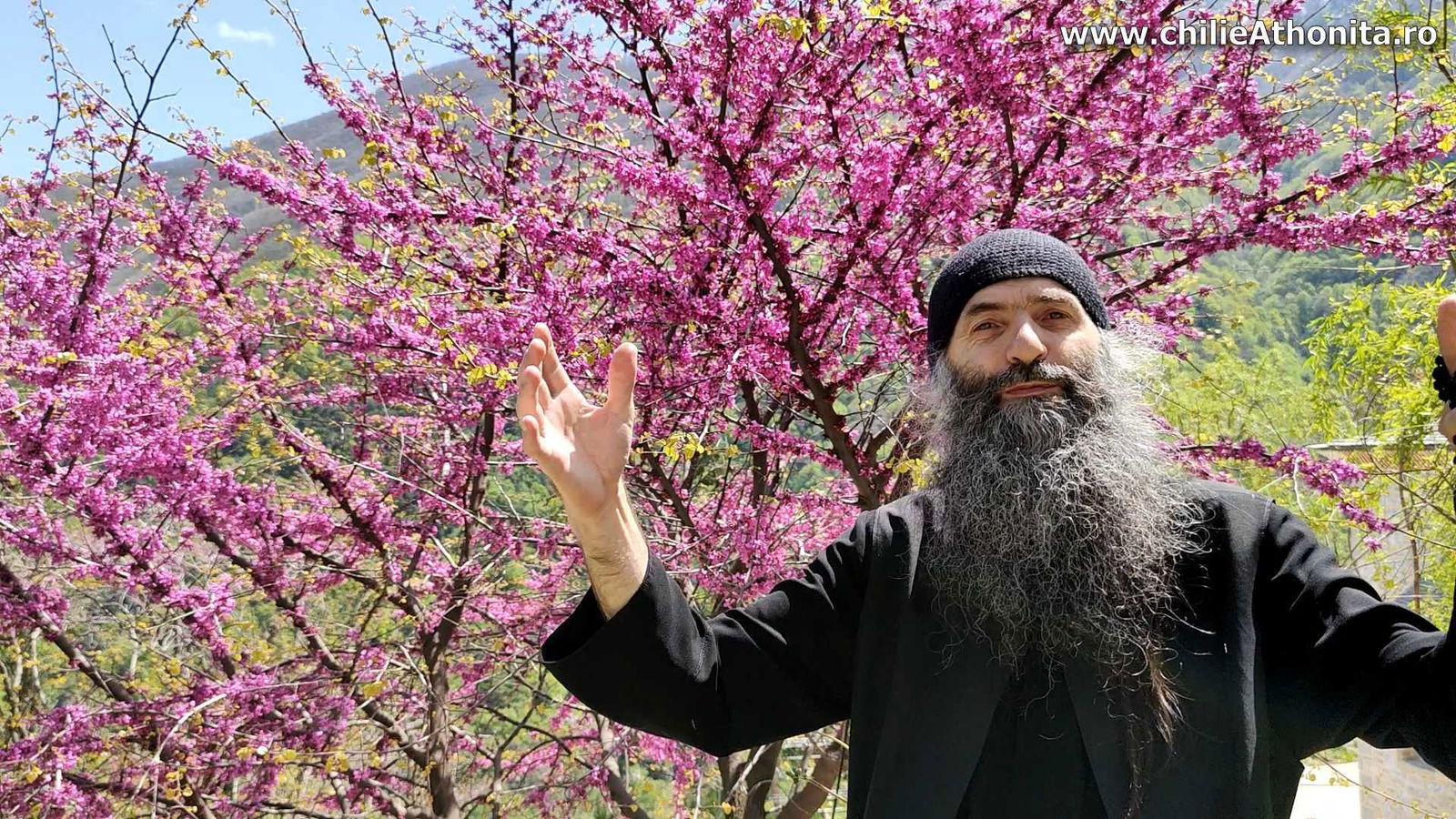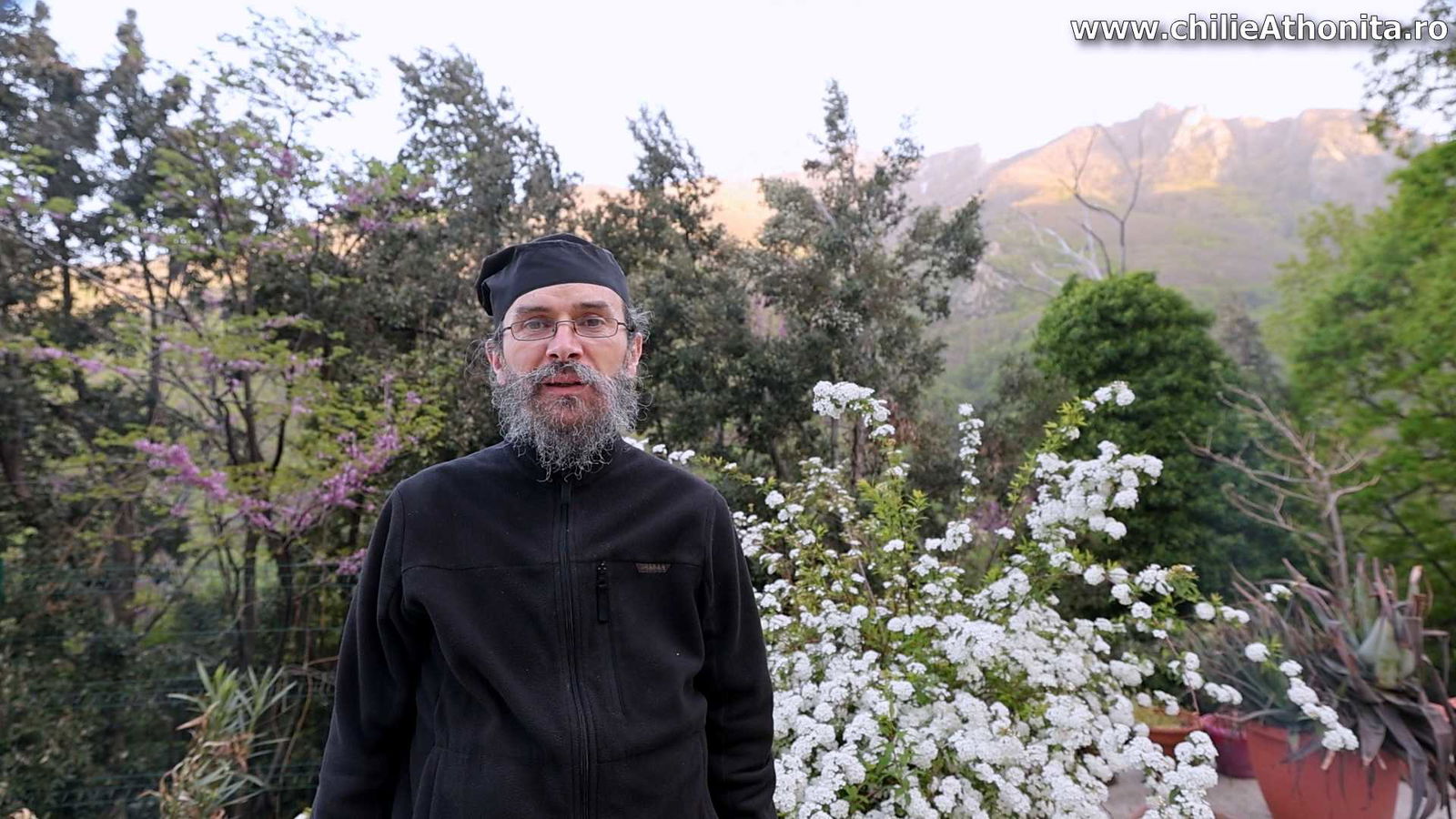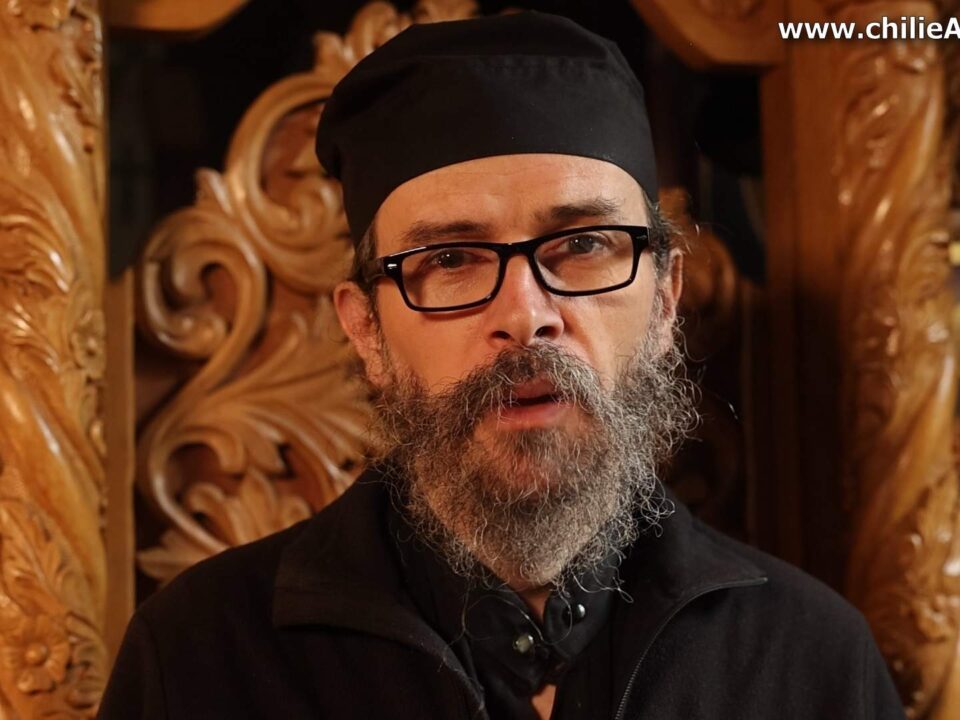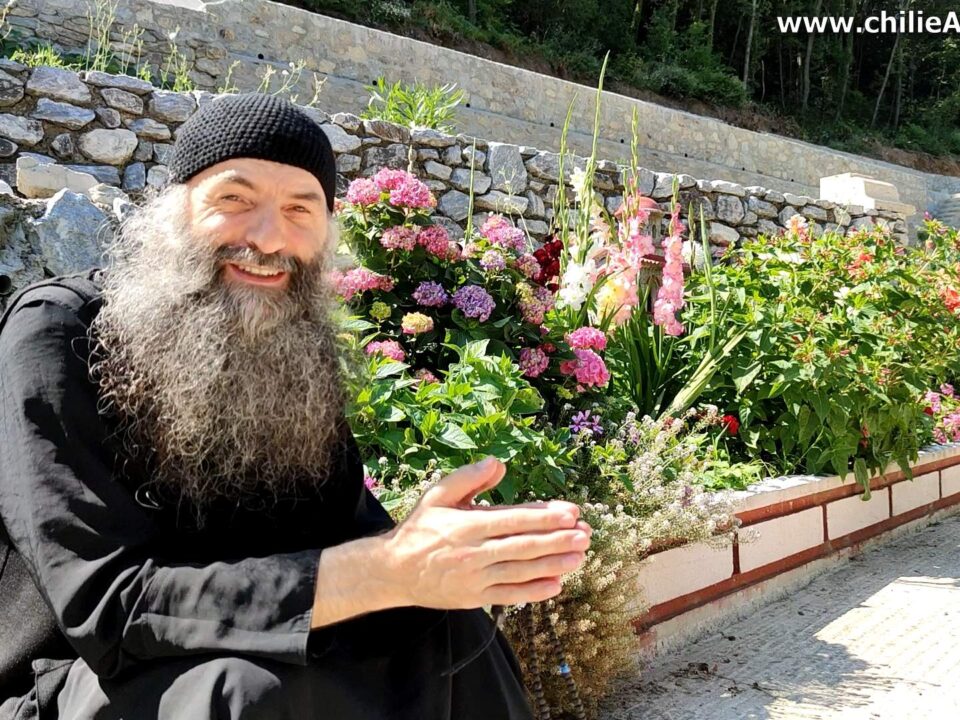
Resurrection and Pain – Father Pimen Vlad
28 April 2022
Reincarnation or Resurrection? – Father Theologos
3 May 2022A new saint was canonized in the Orthodox Church. What is the path of holiness? Which road must we take to reach our goal, to become gods too? Who is the saint?
Watch this video to find out.
Enjoy!
So think about it, a demonized saint. Because he had spiritual measures. He had great spiritual measures.
Glory to the Father, and to the Son, and to the Holy Spirit, both now and forever, and unto the ages of ages. Amen. Through the prayers of our holy Fathers, Lord Jesus Christ, Son of God, have mercy on us! Amen.
Today we will speak a little bit about Thomas Sunday, and what is really important about Thomas Sunday is that it’s a very great feast day. Why? Because on Thomas Sunday it can be seen how man becomes holy, what the road of sanctification is. That’s a little surprising, isn’t it? Yes, it has to be explained, but to do this, let’s start to slowly talk about what happened on Thomas Sunday based on Scripture. Because the text is very short, I’m going to speak a little freely, so I’m not going to read exactly from Scripture as I usually like.
What happened? The providence of God made it so that Thomas was not present when the resurrected Savior first met with the apostles. Why? In order for Thomas to experience God for all of us. That is, for Thomas to put his finger on the mark of the nails, in His side. Do you understand? That is very important. We believe in God, but someone had to experience it in a practical way. The apostles of course saw the Savior, but Thomas par excellence experienced, put his hand. Because otherwise, St. Thomas would have said: “Well, you have seen Him, you have known Him risen, you have had the experience of Him, but I have not had this experience of the Resurrection of our Lord Jesus Christ so then how can I preach Him since I have not had this experience?!” Do you understand? Because of this the presence of the Holy Apostle Thomas is very important so that he could experience for all of us. That is, he could put his finger. And you see that the Lord God was very, very humble. That is, He approached Thomas and said, “Come, put your finger in My side.” A gesture of great humility and one that brings a lot of joy. He said, “Bring your finger here and put it in My side, and put it also in the mark of the nails, in My palms, that you may see that I am risen and that you may no longer be unbelieving, but believing!” Understand?
On the one hand, the Savior is very humble, on the other hand the Savior is very serious. He does not validate Thomas’s unbelief, and on the other hand He brings a lot of joy. This is the quality of humility, you should know. Humility is the seriousness which brings joy. It is naturalness… This is a great mystery because usually when we say that someone is serious, they don’t bring joy. On the contrary, brethren! You should know that the serious man brings a lot of joy. What you see today in the society far from Christ is not joy, it is laughter… or what to call it?… A pseudo-cheerfulness. Do you understand? That’s not true joy. True joy we see in the saints. See St. Demetrius Stăniloae! How serious he is, but how much joy he brings. Or St. Cleopas, right? We see in his videos how serious he is, but how much joy he brings. This is true man, the humble man: the man who is both serious and also brings joy. Do you understand? That is very important.
So when Thomas saw this, he exclaimed, “My Lord and my God!” Meaning he was in so much awe, at his very young age – about 20-something years old… He was young. He marveled at the behavior of our Lord Jesus Christ so much, he was literally in awe. He said: “My Lord and my God! Wow!” Do you understand? And you see that the Evangelist does not even write down whether he put his finger or not. Because truly he had put his finger on the personality, he had the experience of the personality of our Lord Jesus Christ. It is very possible that he may have touched His body as well, – as seen in the icon – but the holy Fathers note that this is totally and utterly secondary, because of course seeing in front of him the living Lord God, the risen One, he said, “Wow! This is it!” Do you understand? He had the experience. And the saints, you should to know, are not saints based on what they have read. Saints are saints based on the fact that they had the experience, they put their finger, as I said. That’s what the saint is. The saint is the one who has the experience, not the one who reads.
Now, who is the saint? You need to know that there are three states, three phases in the life of man. The state against nature, in which man works his passions, and in this state he is tormented and if he dies, this state leads him to hell. After that, we have the state according to nature, in which man works his virtues, that is, man is natural. And in this, man is saved. At this stage, the joy I was talking about, this seriousness, is slowly starting to appear. Let’s be a little serious brethren! And we have the state above nature. Meaning charisms appear. We are talking about, for example, the knowledge of thoughts, even if this was formerly a natural grace, today it has become a grace above our fallen nature. Healing others, working miracles and so on. These things are side effects of the state above nature. Of course, at this stage we have the other charisms – love, joy, peace, long-suffering… Understand? All these things lead to holiness. So if the state against nature leads to hell, the state according to nature in which the virtues are worked leads to salvation. And the state above nature leads to holiness, when the charisms appear, as I said. Charisms are the most above nature, I mentioned them: miracle-working, or even some charisms that were supposed to be natural, but today they have become above nature, including love brethren, you should know. Godly love, which, you know very well, is very difficult to reach today. Although God gives this charisma so easily but we are not interested. Yes…
The necessary and sufficient condition, for someone to be holy, is for man to reach the state above nature. Okay, but that’s an inner thing of the saint. So how do we know about it? We know this from the reverence of the people. So if the Holy Spirit works through the people, through the God-loving flock, through the Church, and many say that this particular person is holy, then that person is holy. That is, if the Holy Spirit creates the consciousness in many people, over a long time, that is, over a great space-time continuum, that the person in question is holy, then that person is holy. Because the Holy Spirit, giver of charisms, says to people, “Hey, see that he is holy.” There’s no need for miracles, that is in appearance, nothing is needed, it just takes people saying this. And of course people say this by seeing the charisms of the saint, first of all his love, which, as I said is a very great charism. And brethren, we do not refer here to the natural love, meaning, the mother’s love for the children, which is also a charism from God, a really great one. But we refer to the divine love, the love that father Cleopas had – Saint Cleopas – Saint Demetrius Stăniloae, Saint Paisios, Saint Porphyrios and so on. Understand?
The act of canonization, brethren, of which everyone makes such fuss, is a very new fruit, you should know. It is very important and it is good to have an act of canonization so that we are protected from extremes, where someone has reverence for someone and immediately… But like I said, it’s a very new phenomenon. The first time it was in the time of St. Gregory Palamas when a disciple of his, St. Philotheus Kokkinos (both are Athonite saints, you should know) St. Philotheus Kokkinos, being the Patriarch of Constantinople, gave an act of canonization, of formalization of the cult of St Gregory Palamas, a cult that already existed. Meaning, everybody knew he was a saint, St. Philotheus Kokkinos didn’t just say, “Everyone, look, he is holy! Honor him.” No! Rather they all considered St. Gregory Palamas a saint, and this formalization came from the Holy Synod of that time. Now, you should know that the greatest saints, because, as I said, there is a lot of fuss over the act of canonization – the greatest saints do not have acts of canonization. I said that the first was St. Gregory Palamas. So the Mother of God does not have an act of canonization. St. John the Baptist does not have an act of canonization. The 12 Holy Apostles do not have acts of canonization. Saints Demetrius, George, Theodore, whoever you want… all the great saints of the first 1300 years have no acts of canonization. Do you understand? They do not have acts of canonization.
And again, to give you another example, for you to understand that it is about the reverence of the people and not about the act of canonization itself – meaning no one comes and says this one is a saint, this one is not a saint – there is the famous case, which I know very well, as I am from Transylvania: the famous case of Avram Iancu. Believe me, in Transylvania there is an undeniable cult of Avram Iancu. Brethren, I know. I have been to Țebea, I have also been to Mount Găina, we know what “Crăişorul Munților” means. [the “Ruler of the Mountains” – referring to Avram Iancu] All Transylvanians have this great reverence to Avram Iancu, but the Holy Spirit never said, never created in the people the consciousness of Avram Iancu’s holiness. Do you understand? It said – Avram Iancu is a great national hero – and that’s it.
Although in Avram Iancu’s life there are no issues to speak of… But in the case of St. Stephen the Great, although some dispute his holiness, saying, “What did the saint do in his life?” and so on… “He killed… .” In the case of St. Stephen the Great, from the time he was still living, the reverence of the people was so great that he was considered a saint, while he was still alive. We should understand this. And even Grigore Ureche, the chronicler, notes it, paying attention to the fact that Grigore Ureche had no reason to praise Saint Stephen the Great and to note his holiness, because the Ureche family apparently was arguing with the saint, because the saint had taken a vineyard somewhere in Odobești, it was a landholding problem… And so Grigore Ureche had no reason to praise St. Stephen the Great and because of this the chronicler notes: “There were this Stephan Voivode not great in stature” that is, he was short. “and quick to spill blood, at feasts [drinking] without measure” so says the chronicler. “And some say he is sviat.” ‘Sviat’ in Slavonic means ‘holy’. And from there on, the chronicler notes a lot of evidence of the holiness of St. Stephen the Great. So the reverence of the people is so strong that not even… not to say the bad intention of the chronicler, but let’s say… not even the somewhat neutral positioning of the chronicler drowns out this holiness of the saint, that must be recognized by the chronicler of the time, and until today among the people. And the Holy Synod did very well to validate his holiness by an act of canonization of St. Stephan the Great. Understand? It is not good to discuss and doubt such opinions, nay, such decisions of the Holy Synod because it is not an opinion.
It’s very good that I mentioned ‘opinion’, you should know that it is not an opinion, but is a confirmation of a national position. That’s the act of canonization, it’s not the opinion of the Holy Synod. Do you understand? Because of this, once again, we greet and bow down before the Holy Synod and the Romanian Orthodox Church for having formalized this cult.
Now… Speaking of saints and canonizations, you should know that recently the Venerable Eumenios Saridakis, a saint from Greece, was canonized. Father Eumenios was a father who emanated a lot of joy, a lot of joy. He was – He is – (however you wish to say it because the saint is alive in heaven), we usually say “he was” because he left this world… He was a priest who emanated a lot, a lot of joy. How was he so joyful? Well, how? Let’s remember the Holy Apostle Thomas, right? The Holy Apostle Thomas was so joyful because he met Christ. Likewise, Father Eumenios was so joyous because he met Christ. Well, but the Holy Apostle Thomas first of all had the experience of Christ crucified. Likewise father Eumenios had the experience of Christ crucified. Exactly the same road. It’s the road of holiness as I said. Of course, father Eumenios did not have the experience of Christ in the flesh, as Thomas had – that is, he saw the Savior in front of him. Or the experience of Christ – that he saw the crucifixion of the Lord as the Holy Apostle Thomas saw it, but practically, in his life. First of all, saint Eumenios lived Christ crucified because he had great pains. Very great pains. First of all, you need to know brethren that he was a leper. Saint Eumenios Saridakis was a leper. And he was healed. It was a terrible time for him. So it wasn’t these pains of, for example, my brother is telling me, I don’t know… “You’re a bastard, you’re a pig…” and for me it’s the end of the world because my brother spoke a little harshly to me. No, brethren. The man was a leper for years. Do you understand? And not only did he suffer that, but after healing, he was fighting with the demons terribly, you should know. They beat him, he had demonic experiences and all this and the saint did not back down from his faith, he did not despair.
Brethren, we despair when we have thoughts. We must not despair when we have thoughts! We don’t have to believe our thoughts that say, “That’s it, you’re of hell, so I am of hell.” I’m not of hell. Like I said, there were people, and there are still people today, who are fighting devils who are very concrete things, bone on bone. Of course they are types of minds, but because devils have a very great power, allowed by God and especially by the sins of men – because people give them this power – devils can fight man, they can cause him these pains. Understand?
And Saint Eumenios fought the devils so much until he overcame them. He overcame them… he thought he had overcome them. Because at some point a state of satisfaction came over him, “That’s it, I’ve won!,” he was thankful, he was pleased. This happened when he was at the infectious disease hospital so he was already healed as I said. He was the priest there, he was parish priest, whereas before he had been a patient for years. He was a parish priest there, and when he had this thought of being pleased — that he had won— that’s when he became demonized. That’s when he became demonized brethren, you should know. And he again went through another period of his life in which others tied him up, they took care of him…it was really bad. So we’re talking serious things, not like… “I argued with my brother because he gave me a mean look” or God knows what… So think about it, a demonized saint. Because the man had spiritual measures, he had great spiritual measures. Of course he was in the making, that is, he was in the growth of his holiness, because you should know, brethren, that holiness is not a ceiling that someone hits their head on and stops there.
Holiness, as we have seen in the Holy Apostle Thomas and we also see in Saint Eumenios, is a very dynamic process, an increasing process of knowing Christ, first crucified, and after that, resurrected. It’s this experience. And of course he was delivered from demonization – by whom? By the Mother of God through a miracle-working icon of hers. It’s called Mother of God Koudoumά. A miracle-working icon from Greece. And after this, Saint Eumenios was healed. Okay, but the next step, as I said, is the experience of Christ. He had to put his finger in the risen Christ. Of course, in the case of Saint Eumenios, Christ did not appear before him, but Christ appeared in one of His people, that is, in an abba, in a saint. Because in the saints Christ is resurrected. And who was the Saint who spiritually guided him? Who was the saint in which father Eumenios – the future Saint Eumenios – saw Christ? Who was his gheronda? Who was his spiritual leader? It was another leper – Saint Nikephoros the Leper. Do you understand? So brethren, let’s understand each other, everyone has to go through the cross! This is very important. And all of this was happening around the 1960s. And St. Nikephoros in whom Christ was already resurrecting, transmitted to the father, to St. Eumenios, this charism of his, this resurrection of Christ by touching, that is, by the obedience of Saint Eumenios to St. Nikephoros. Do you understand?
Based on these experiences of Christ crucified, on the encounter with the man of Christ, as I said, like Thomas putting his finger, this is how Saint Eumenios became a saint. So this is the road of holiness, understand? And based on everything I’ve said so far, St. Thomas is the archetype, is the prototype of the man who becomes holy even in the missionary activity, because, as I said, this happened in 1960s (somewhere in those years, I don’t remember well), and after that, Saint Eumenios preached – preached Christ. He passed Him on. Like the Holy Apostle Thomas.
So because of this brethren, the Sunday of Thomas is a very, very important feast, the touch of St. Thomas, because it actually shows man’s way to holiness, the stages of sanctification, as I said: the living of Christ crucified, after which the sight of Christ and the touch, the experience of Christ, (not the reading about Christ) and then the further preaching of this experience. The struggle, the pain is very important, after which, the abba – the spiritual leader and, after that, if the good God wills it, if we have come to know Christ through the abba, then we will tell the others that we have touched the risen Christ.
Christ is Risen! May the good God help us!
Through the prayers of our holy fathers, Lord Jesus Christ, Son of God, have mercy on us! Amen.
Online commemoration lists and donations
May the Lord help us!
Online Commemoration Lists and Donations
May the Lord help us!
If you have a bank card and wish to send commemoration lists and donations online using your card, and/or to support our philanthropic activity, including this site, please fill out the form below to make a small donation. The form is secure – we use Stripe for payment processing – a world leader in this field. We do not collect your personal data.
If you do not have a card, or do not wish to use it, visit the webpage for Online Donations and Commemoration Lists.
We will pray for your loved ones! (Please do not include inessential details like wishes, degree of kinship, introductions etc. JUST the name!)
Especially for recurring commemoration lists, we ask that you please keep them to under 20 names long. If you include a member of the family, we add “and for their families.”







